Smart Portfolio
Solutions
Example Portfolios Geared to Growing Your Wealth in Any Market Environment
Not Your Standard Stock / Bond Portfolio
At Signals Matter, we recognize the value of hard-earned wealth and are here to grow and protect it. With interest rates volatile, bonds no longer provide a “safe-haven” hedge against stock declines. Stocks too are over-valued, which means double-trouble for traditional investing. Keeping your money safe requires diversification outside of just stocks and bonds to less-correlated, alternative solutions. That's what we do; that's how we help.
Commodities & Energy
Metals & Currencies
Inverse Strategies

Why Our Portfolios are Different
Better performing portfolios are portfolios that are diversified beyond stocks and bonds. Meaningful diversification is not about growth vs. value, or high-cap vs. low-cap, or stocks vs. bonds. It's about allocating smartly across less-correlated asset classes that include real estate, currencies, commodities, precious metals, sector-focused funds, countries, and other alternative choices, including inverse investments that make money when stocks and bonds fall. Signals Matter portfolios are:

Truly Diversified
Our truly diversified portfolios incorporate all asset classes, not just multiple flavors of highly correlated stocks and bonds, with emphasis on containing interest rate risk.

Actively Managed
Actively-managed portfolios zig when the markets zag, providing important portfolio protection as stocks fall, interest rates rise, and business conditions deteriorate.

ETF Invested
We populate our portfolios with cheaper, easier-to-trade, and more tax-efficient ETFs that provide our investors options for diversifying away from stocks and bonds.
We Care About
Market Risk

Our Lighthouse Operates 24/7
Warning of Dangerous Shallows
And Perilous Markets Ahead.
- Measuring global market risk is a strategic concept, requiring disipline, planning, implementation, and constant monitoring of global macro and market risk factors.
- Containing market risk provides an extra layer of protection when markets tumble, helping guide investors safely into and out of financial markets.
- Every portfolio we manage is accordingly risk-adjusted.

Market Risk
How We Measure
Measuring global market risk is a strategic concept, requiring discipline, planning, implementation, and constant monitoring of global macro and market risk factors. Containing market risk provides an extra layer of protection when markets tumble.
Risk Factors
How We Monitor
We monitor market risk by constantly parsing current and forecast GDP; yield curve variances; trends across global equities, bonds, currencies, and commodities; and an extensive array of leading and proprietary indicators that forecast stormy weather ahead.
Portfolios
How We Apply
Market Risk scores inform on the percentage allocations of short-term treasury and inflation-protected ETFs across our three portfolios, allocating more to the Conservative Portfolio, less to the Moderate Portfolio, and none to the Aggressive Portfolio.
Questions answered
How about a bit of background on Signals Matter?
Signals Matter, LLC was founded in April 2017 by Thomas Lott and Matthew Piepenburg as an online publishing company to provide subscribers with timely financial market analysis and specific portfolio investment ideas.
Is this a Trading Service?
No, although we are working towards launching a hedge fund for accredited investors at Signals Matter Advisors in Q1 2024 that will automate Model Portfolio investing. On the publishing side, for Signals Matter subscribers, we provide information and illustrations for informational and educational purposes only that are not intended as investment advice or as a recommendation to buy or sell any security. The information provided reflects our views and research and should not be interpreted as investment advice, an offer or solicitation, or a direction to purchase or sell any financial instrument. Our views concerning economic market trends and risk probabilities are based on market conditions that will fluctuate. There can be no assurance that a subscriber will achieve profits or avoid substantial losses by investing in the Portfolio Suggestions presented by Signals Matter. The past performance of any posted Suggestion is not indicative of future results.
Why do Signals Matter?
Market signals matter when investing, building all-weather portfolios, and managing risk. We created Storm Tracker, our mathematically derived algorithm, to inform on market risk and determine appropriate cash exposure across our portfolios.
What is Storm Tracker?
Storm Tracker tracks the probability of stormy weather ahead (market stress) by monitoring over a hundred metrics that track GDP, Sector Trends, Leading Indicators, Yield Curves, and Déjà Vu, our in-house risk indicator that compares yield spreads with stock movements. Storm Tracker measures overall market risk from 0% (no market risk) to 100% (extreme market risk).
How is Storm Tracker Applied?
As broad market risk rises, cash allocations within the Conservative to Moderately Aggressive Portfolios also rise. There are no Storm Tracker allocations for the Aggressive Portfolio.
Is investing an art or a science?
Constructing portfolios that hold up in all weather conditions is more than a science. It's an artful science that builds upon informed investing, market cycle discovery, meaningful diversification, risk reduction, technical analysis, and proper benchmarking — all geared to optimize return and minimize risk.
What Model should I choose?
We encourage subscribers to choose a Model Portfolio suited to their capacity to take on risk, risk tolerance, and potential market instability, as indicated by Storm Tracker.
What investment instruments do you deploy?
Signals Matter draws heavily on exchange-traded products (ETP) to populate its portfolios. ETPs are exchange-traded investment vehicles that include two subsets, Exchange Traded Funds (ETFs) and Exchange Traded Notes (ETNs), with allocations to ETFs by far the greater of the two. The universe of ETPs provides traditional but also actively managed solutions that enable investment subscribers to diversify away from traditional stocks and bonds during adverse market conditions for traditional investing. Signals Matter tracks over 2,000 US-domiciled, liquid ETPs across stocks, bonds, currencies, commodities, actively managed, and inverse ETPs (the inverse of long-only indexes). Inverse ETPs provide simple, cheap, and liquid solutions to hedge (i.e., short) specific market sectors within our portfolios, enabling subscribers to profit should stocks fall. Unlike mutual funds, which price at the end of the day, ETPs are priced continuously during each market session, affording frequent and continuous price discovery.
What does "alternative investing" mean?
Alternative investing is a core strength at Signals Matter, is deployed across all Signals Matter portfolio solutions, and is a prime differentiator from traditional Financial Advisors (FAs) and Registered Investment Advisors (RIAs). FAs and RIAs invest primarily in stocks and bonds. Alternative investing relates to investing in anything that's not a stock or a bond, as with private equity, venture capital, real estate, hedge funds, managed futures, art and antiques, commodities, derivatives contracts, and alternative-oriented Exchange Traded Products (ETPs). Alternative investing diversifies portfolios and can be performance-enhancing during systemic market change or stress.
What's the difference between "active" and "passive" portfolio management?
Active portfolio management takes a hands-on approach to portfolio construction, going when and where the opportunities arise. Passive investing involves less buying and selling, often resulting in portfolios populated with traditional stocks and bonds. While active and passive investment approaches each have a role to play, both are highly dependent upon the macro environment.
At Signals Matter, we believe that active portfolio management beats passive portfolio management hands down during periods of extreme market stress, at market tops, and during changing interest rate regimes. For us, meaningful diversification is more than growth vs. value, high-cap vs. low-cap, or stocks vs. bonds. It's about allocating smartly across less-correlated asset classes, including real estate, currencies, commodities, precious metals, sector-focused funds, countries, and other alternative choices, including inverse investments that make money when traditional stocks and bonds fall.
Portfolios managed actively can zig when the markets zag, reducing portfolio volatility, thus providing a calmer ride with the potential to compound to higher place over time.
How do I get started?
Simply click Sign Up on the toolbar, or click on Subscribe Now below.
Our purpose is to educate
Important Disclosures
Signals Matter content is provided for informational and educational purposes only and is not intended as investment advice or as a recommendation to buy or sell any security. Information contained on the Signals Matter website is based upon our views and our research and should not be interpreted as investment advice, as an offer or solicitation, nor as the purchase or sale of any financial instrument. Statements concerning financial market trends and recession probabilities are based on current market conditions, which will fluctuate. There can be no assurance that an investor will achieve profits or avoid incurring substantial losses by investing in the Portfolio Suggestions presented by Signals Matter. Past performance of any posted Suggestion is not indicative of future results.
